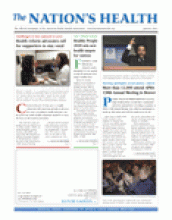Despite slight gains in reducing the nation’s overall rate of premature births, a national report card has again handed the United States a below-average grade.
The report card, released in mid-November by the March of Dimes, assigned the United States — where one in eight babies is born too soon — a grade of D for its overall preterm birth rate of 12.3 percent. The report card measures preterm birth rates against the federal government’s Healthy People 2010 goal of lowering the rate to 7.6 percent of all live births.
More than 500,000 babies are born prematurely each year in the United States. Preterm birth — defined as being born before 37 weeks of pregnancy — causes serious health issues and costs the nation $26 billion annually, according to the Institute of Medicine.
“Our country has one of the highest rates of preterm birth in the world,” U.S. Surgeon General Regina Benjamin, MD, said in a statement releasing the report. “We have to do better. As a family doctor, I’ve seen the terrible impact of premature birth. It can cause lifelong disabilities, and it is the leading cause of deaths in newborns.”
Measuring individual states’ rates of premature birth against the federal objective, the report card assigned grades of C to 17 states and grades of D to 20 states. A total of 13 states, the District of Columbia and Puerto Rico took home failing grades for their rates of preterm birth.
No state earned a grade of A or B on the March of Dime’s 2010 report card. Vermont continues to have the nation’s lowest preterm birth rate, with 9.5 percent of all live births occuring prematurely, up slightly from 9.2 percent in 2009. The slight increase caused Vermont’s grade to drop from a B in 2009 to a C this year.
At 18 percent, Mississippi had the highest preterm birth rate in the nation, followed by Alabama at 15.6, the District of Columbia at 15.5 and Louisiana at 15.4 percent.
Preterm birth is the leading cause of newborn death and a major cause of lifelong disability. Even when babies survive a premature birth, they face the risk of serious lifelong health problems, including learning disabilities, cerebral palsy, blindness, hearing loss, asthma and other chronic conditions, according to the March of Dimes. Even infants born just a few weeks too soon have a greater risk of breathing problems, feeding difficulties, hypothermia, jaundice and delayed brain development.
But policy changes and programs to prevent preterm birth in the United States are starting to pay off. Eight states saw their grades improve on the “Premature Birth Report Card,” and 32 states and the District of Columbia saw their preterm birth rates improve. Additionally, following three decades of increases, the report highlights the first two-year decline in the preterm birth rate.
Additionally, most states saw improvements in one or more of the three areas tracked by March of Dimes. For example, 28 states and Puerto Rico saw reductions in the percentage of women of childbearing age who smoke, and 17 states and the District of Columbia reduced the percentage of women of childbearing age who lack health insurance. Also, 37 states and Puerto Rico lowered their late preterm birth rates, which tracks infants born between 34 weeks and 36 weeks gestation.
Strategies for lowering the risk of an early birth include smoking cessation, preconception care and early prenatal care.
“The two-year declines we have seen nationwide, though small, are encouraging,” said Jennifer Howse, president of the March of Dimes, in the November statement releasing the report. “We believe this decline is the beginning of a trend, but must be supported by better health care, new research and adoption of intervention programs to lower the risk of preterm birth.”
To download the “Premature Birth Report Card,” visit www.marchofdimes.com.
- Copyright The Nation’s Health, American Public Health Association









